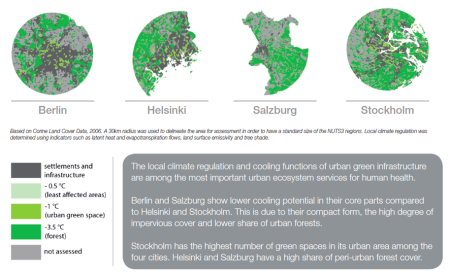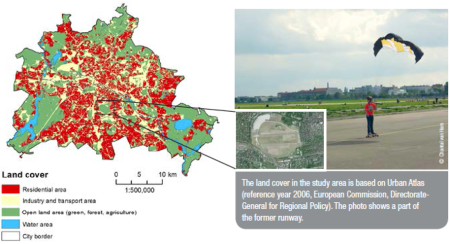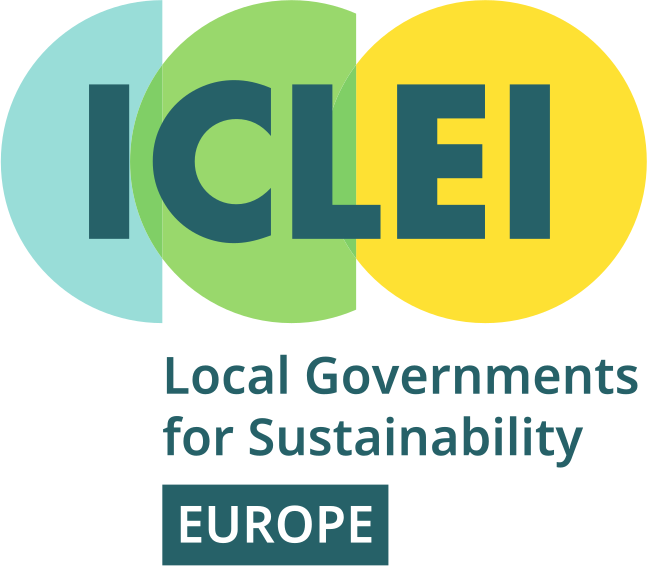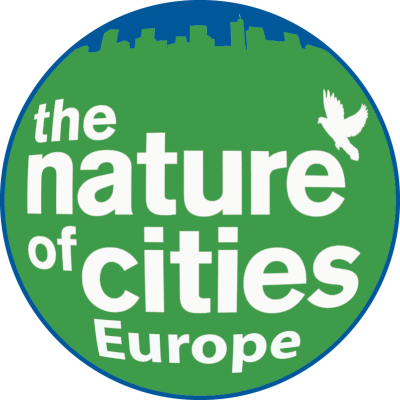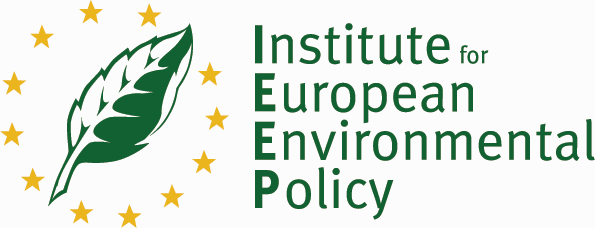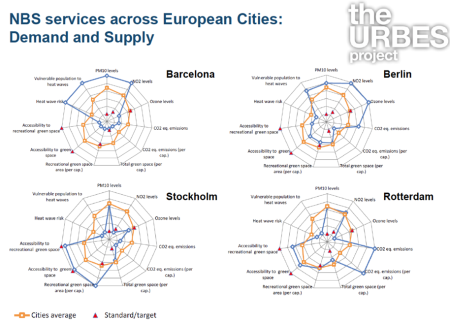
Area characterisation:
Berlin is the capital and the largest city of Germany with a population of 3.4 million people. Berlin is influenced by a temperate seasonal climate, and around one third of the city's territory is composed of forests, parks, gardens, rivers and lakes. The city itself is in a transition because of its tremendous population loss after 1940. Today, Berlin is characterized by simultaneous urban growth and shrinkage (of population), residential vacancy on the one hand, famous (re)construction sites on the other. Next to built-up residential (25%), transport and commercial land use, forests, parks and wooden areas >40% a dominant land use which makes Berlin’s city area special and worthwhile for investigating biodiversity and ecosystems. 25% of the area is covered by arable land. Future scenarios for Berlin are primarily driven by global climate change, change in world markets and of the finance sector. Internal drivers such as demographic change and ageing, land use perforation, increase of urban brownfields and inner-urban reurbanisation affect the city region. In terms of ecosystem functions and services, Berlin will be affected by climate change and heat waves (several times in the last decade), increase of poverty and environmental injustice.
For more information on the context of the Berlin case study: https://www.youtube.com/watch?v=Yq1QtmmZTbs
Objective:
The URBES project focusses on functional diversity, urban ecosystem services and NbS, institutions, economics and resilience science and worked to translate research insights into principles, landscape designs and applications. It explores the drivers behind loss/enhancement of urban ecosystem services delivered by nature based solutions such as urban green space, monetary and non-monetary valuation of biodiversity and ecosystem services in the urban landscape and what are the most effective mechanisms for the governance of non-marketed ecosystem services.
In the Berlin case study, the objectives were to i) compute general ecsosystem services at the city level and work on their valuation, and ii) Raise stakeholders’ awareness about these ecosystem services and co-develop scenarios of urban planning changes and related impacts on the delivery of ecosystem services.
Images
Financing:
This research was funded through the 2015-2016 BiodivERsA COFUND call for research proposals, with the national funders PT-DLR (Germany), NCN (Poland), RCN (Norway) and MINECO (Spain). For more iformation on BiodivERsA, visit http://www.biodiversa.org/
Potential impacts/benefits:
The results were built and analysed with stakeholders of the project, and the participatory scenario development exercise allowed transferring results on the impact of different urban planning change on the delivery of ecosystem services at the city level.
Actions:
Ecosystem services calculation and valuation work: see results presented in the publications and URBES factsheets, in particular:
- A quantification of ecosystem services demand and supply in 4 cities including Berlin was published by the URBES project (see Baro et al. 2015). Ecosystem services include air purification, global climate and urban temperature regulation.
- Analysis of ecosystem services implementation and related governance challenges in green space planning (see Kabisch 2015): Based on an analysis of strategic planning documents and expert interviews with local stakeholders, this work explores to what degree the ecosystem service framework is integrated in the planning system and iden-tifies major challenges in urban green governance. As an output of the analysis of planning documents,it is identified that only very recently developed informal strategies explicitly relate to the ecosystemservice framework although stakeholders are aware of the term. Identified main challenges in Berlin’surban green governance include (a) increasing development pressure from population growth and finan-cial constraints on the municipal budget, (b) loss of expertise and (c) low awareness of green benefitsamong different actors through insufficient communication. The concept of ecosystem services, how-ever, may provide a useful argument to promote the conservation of existing urban green spaces and tocommunicate the benefits that urban nature provides for citizens to all levels of green space governance.
- Biodiversity and ecosystem services: the foundation for human health and well-being - URBES Factsheet #2: this factsheet presents research findings and policy recommendations which underline the value of biodiversity and ecosystem services in building and protecting physical and mental health, with a cross comparision of heat reduction effect through natural solutions in Berlin, Helsinki, Salzburg and Stockholm (https://www.oppla.eu/product/2084)
- Urban resilience and sustainability - URBES Factsheet #5 : This factsheet explains the importance of understanding the relationship between people and nature in urban planning and decision making in order to achieve urban resilience and sustainability, with a case study on brownfield regeneration in Berlin, in the former Templehof city airport (https://www.oppla.eu/product/201)
The project performed interviews to gather stakeholder perceptions and uses of the ecosystem services concept, with questions on its understanding, uses in planning and decision-making, how it may/may not inform decisions (see Kabisch 2015)
Participatory scenario development on present and projected delivery of ecosystem services according to different urbanism plans across European cities (see Haase et al 2014b)
Transferability of result:
The results are generally transferable for urban planning, although specific to Berlin and tailored according to local development plans and land use. Nonetheless this research is part of the URBES project, with related case studies in 7 European countries.
Lessons learnt:
Accessibility and availability of green space is found more important than its relative size. The structure and key features of urban green space, rather than e.g. size per capita, are more effective measures of the delivery of ecosystem services, especially related to public health and human well being.
Socio-cultural factors strongly influence the use of urban green spaces and urban forests by inhabitants, which could be better accounted for in green space planning and development. See examples on immigrants and older aged groups (Kabisch and Haase 2014), health inequalities among children (Kabisch et al 2016) or related to urban forest management (Larondelle and Haase 2017)
Organisations:
Berlin administration and local authorities (Berlin Senatsverwaltung), including divisions in:
- Landscape development
- Green planning
- Climate adaptation
- Biodiversity conservation
Local urban foresters
Stakeholders involved in the case study include:
Community representatives and school gardens
For interviews of the stakeholders involved in the Berlin case study: https://www.youtube.com/watch?v=Yq1QtmmZTbs
Contacts:
BiodivERsA Science-policy/society interfacing: Frederic Lemaître (frederic.lemaitre@fondationbiodiversite.fr)
NBS goals:
- Enhancing sustainable urbanization
- Urban regeneration through nature-based solutions
- Nature-based solutions for improving well-being in urban areas
NBS benefits:
- Creation of green jobs relating to construction & maintenance of NBS
- Increase awareness of NBS solution & their effectiveness and co benefits
- Increase stakeholder awareness & knowledge about NBS
- Increase willingness to invest in NBS
Publications and reports:
More information about the URBES project: https://www.iucn.org/content/urbes-cities-and-biodiversity
Publications related to the Berlin case-study:
- Haase et al (2014b), Ecosystem Services in Urban Landscapes: Practical Applications and Governance Implications – the URBES Approach (https://static1.squarespace.com/static/552ec5f5e4b07754ed72c4d2/t/5550a5f5e4b0a8858a7c8b06/1431348725548/haase+et+al+2014b_ugec.pdf)
- Kabisch and Haase (2014), Green justice or just green? Provision of urban green spaces in Berlin, Germany (https://www.sciencedirect.com/science/article/pii/S0169204613002302)
- Baro et al (2015), Mismatches between ecosystem services supply and demand in urban areas: A quantitative assessment in five European cities (https://www.researchgate.net/publication/274460529_Mismatches_between_ecosystem_services_supply_and_demand_in_urban_areas_A_quantitative_assessment_in_five_European_cities)
- Kabisch (2015), Ecosystem service implementation and governance challenges inurban green space planning—The case of Berlin, Germany (https://www.sciencedirect.com/science/article/pii/S0264837714002002)
- Kabisch et al (2016), Adding Natural Areas to Social Indicators of Intra-Urban Health Inequalities among Children: A Case Study from Berlin, Germany (https://www.ncbi.nlm.nih.gov/pubmed/27527197)
- Larondelle and Haase (2017), Back to nature! Or not? Urban dwellers and their forest in Berlin (https://link.springer.com/article/10.1007/s11252-017-0660-7)
Related factsheets from the URBES project:
- Valuing ecosystem services in urban areas - URBES Factsheet #3: This URBES factsheet explains what the values of ecosystem services are and provides examples of their benefits for cities URBES case study in New York City). (https://www.oppla.eu/product/2085)
- The Cities and Biodiversity Outlook – URBES factsheet # 4: At the request of the parties of the United Nations Convention on Biological Diversity, and with strong support from the URBES partners, an international team of scientists has produced the Cities and Biodiversity Outlook. This is the first scientific assessment of how global urbanization trends affect biodiversity and ecosystem dynamics. It explains how biodiversity and ecosystem services can be managed and restored in innovative ways to reduce the vulnerability of cities to climate change and other disturbances. It also provides decision-makers, urban planners and experts with practical guidelines, highlighting the complementary roles of authorities on national, sub-national and local levels in preserving biodiversity in cities as well as in distant places. (https://www.iucn.org/sites/dev/files/import/downloads/urbes_factsheet_04_final_web_1.pdf)
- Green Infrastructure, a wealth for cities - URBES Factsheet #6: This URBES factsheet outlines the key components of Green Infrastructure and explores the linkages between the EU Green Infrastructure Strategy and the urban context (URBES case study in Barcelona) (https://www.oppla.eu/product/2087)
- Urban agriculture: landscapes connecting people, food and biodiversity – URBES factsheet # 7: This factsheet will explain the importance of urban agriculture: the ecosystem services that urban agriculture provides for human wellbeing, food security and urban resilience; and the need for integrated planning across sectors to ensure that the ecosystem services that urban agriculture provides can proliferate (URBES case study in Salzburg). (https://www.iucn.org/sites/dev/files/import/downloads/urbes_factsheet_07_web_2.pdf)
Cultural Ecosystem Services – A gateway to raising awareness for the importance of nature for urban life – URBES factsheet #8 : This factsheet illustrates how Cultural Ecosystem Services offer a gateway to raising awareness of the wide range of ecosystem services provided by nature, their importance for quality of life and human health in cities, and their role in encouraging urban environmental stewardship (URBES case study in New York City). (https://www.iucn.org/sites/dev/files/import/downloads/urbes_factsheet_08_web_2.pdf)

